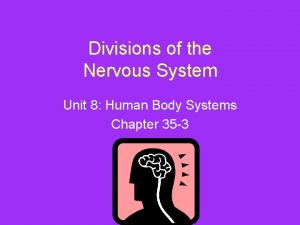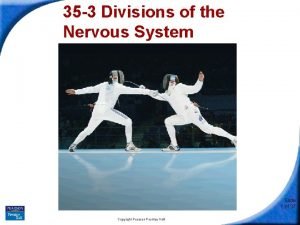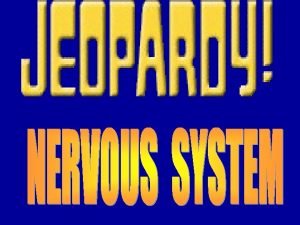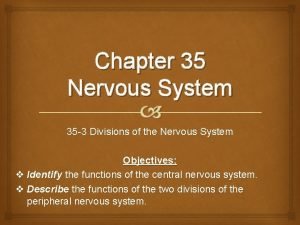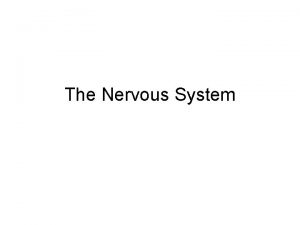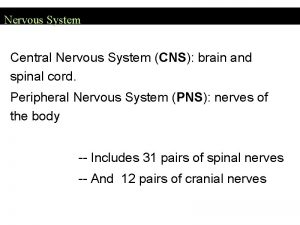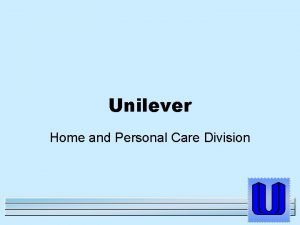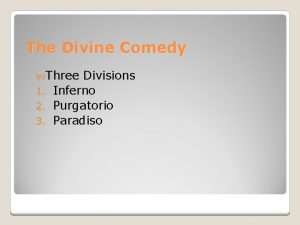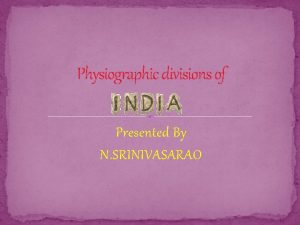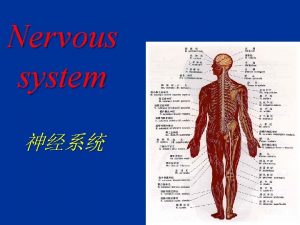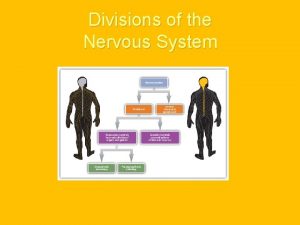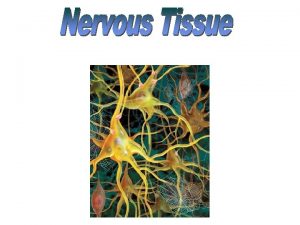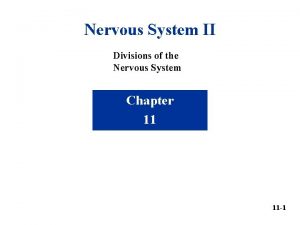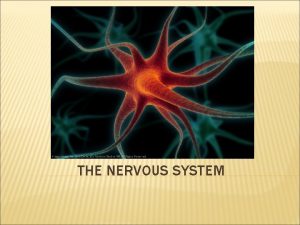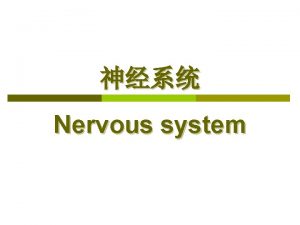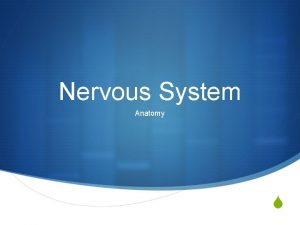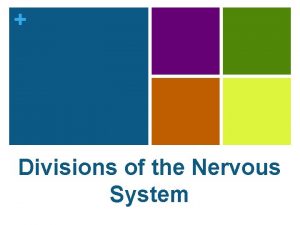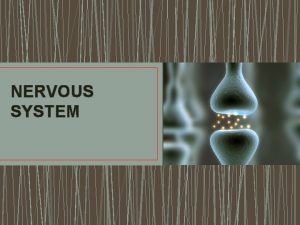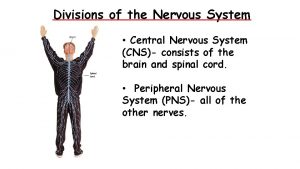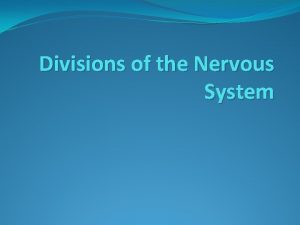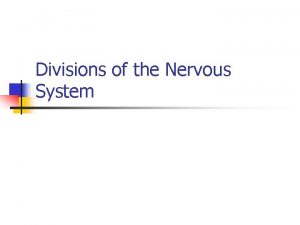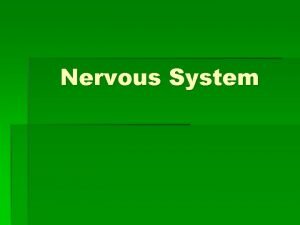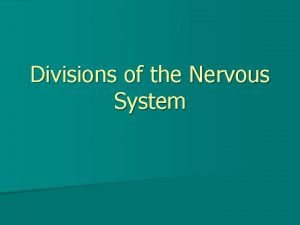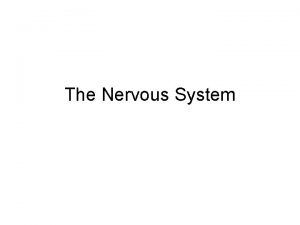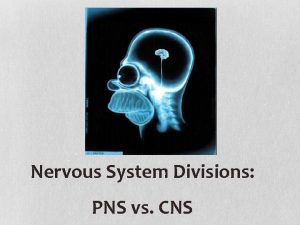Nervous System 2 Divisions of the Nervous System






















- Slides: 22

Nervous System

2 Divisions of the Nervous System: 1. Central Nervous System (CNS) -brain and spinal cord 2. Peripheral Nervous System (PNS) -all other nerves

3 major functions: 1. Sensory function: -sensory receptors detect changes that occur inside/outside body Eg. Light, sound, temp, oxygen -convert into nerve impulses peripheral nerves To #2

2. Integrative function: -peripheral nerves bring impulses together to create sensations, memory, thoughts -make conscious/subconscious decisions

3. Motor function -carries impulses from CNS to effectors Effectors: usually muscles or glands muscles: stimulate contraction glands: stimulate secretions

Somatic Nervous System • Cranial and spinal nerve fibers connect CNS to skin and muscles – Responsible for conscious activities – Part of Peripheral Nervous System

Autonomic Nervous System • Fibers connect CNS to organs and glands -Responsible for unconscious activities 1. Sympathetic Division -prepares body for stressful, energy-expending activities, emergencies -regulates diameter of blood vessels 2. Parasympathetic Division -regulates digestive system movements -regulates normal, restful conditions -restores body after sympathetic activities


Within somatic & autonomic systems… Cranial nerves: originate from brain stem (except for 1 st in cerebrum) How many are there? 12 pairs http: //www. meddean. luc. edu/lumen/Med. Ed/Gross. Anatomy/h_n/cn/cn 1/mainframe. htm Ganglia: sensory fibers with neuron cell bodies outside of brain Spinal nerves: originate off spinal cord How many are there? 31 pairs -branch off 31 segments

What is a plexus? : complex networks of spinal nerves -recombine so fibers reach specific body part at same time 3 major plexuses: 1. Cervical plexus (whiplash) 2. Brachial plexus (stingers) 3. Lumbosacral plexus

What are specialized nerve cells (masses of nerve tissue)? Neurons : supporting cells that are connected by neuroglial cells Neuroglial cells: -supporting cells Functions: -provide framework -carry on phagocytosis -produce myelin -fill spaces

3 structural divisions of the neuron: 1. Cell body -rounded center of neuron 2. Axon -usually one; sends messages 3. Dendrite -usually many; receives messages

Others… Schwann cells: form covering (myelin sheath) around axons Myelin: made up of lipoprotein Myelinated fibers: “white matter”; if insufficient nutrients, this is disrupted *begins at 14 wks…continues until adolescence Unmyelinated fibers: “gray matter” Myelin sheath: actual covering around a axon


Neurofibrils: thin threads that make up nerve fibers Neurilemma: surrounds myelin sheath Nodes of Ranvier: gaps between Schwann cells Nucleolus: center of nucleus (which is in center of cell body)

Do mature neurons divide? No, HOWEVER… A few parts of the nervous system contain neural stem cells, that could possibly form new neurons or neuroglial cells What will it hold for our future? ?

Nerve: A cordlike bundle (or group of bundles) of nerve fibers held together by connective tissue. mixed nerves: contain both sensory and motor nerves How does an infants nervous system compare to an adults nervous system? Myelin begins to form at 14 th week of prenatal development…continues until adolescence Newborn responses often involve entire body (Eg. startle reflex)

How can mercury affect the nervous system? • Neurons gradually die, causing neuroglial cells to “overgrow” • Poor balance • Slurred speech • Difficulty thinking • Twitching hands • Could deteriorate nervous system…eventually causing death

Neuron functions: 1. Sensory neurons: aka afferent -carry nerve impulses from peripheral body parts into the brain or spinal cord 2. Interneurons: aka intercalated -lie within brain or spinal cord 3. Motor neurons: aka efferent -carry nerve impulses from brain/spinal cord to effectors

3 causes of oxygen deficiency in neurons: 1. Ischemia (lack of blood flow) 2. Toxins (block aerobic respiration) 3. Hypoxemia (abnormally low blood oxygen concentration)

Nerve impulse: propagation of action potentials along a nerve axon All-or-none response: states that a neuron will respond completely, or not all resting potential: difference in electrical charge between inside of membrane & outer membrane threshold potential: summation of potentials (many must come together for A-O-N Response) action potential: initiates the impulse; occurs when you reach threshold potential

How do anesthetics affect how nerve impulses are transmitted? : decreases membrane permeability to sodium ions (think conductivity) -prevents impulse from passing through -keeps impulse from the brain (no pain/touch sensations felt) Local: small region (knee surgery, stitches, cavities) General: generally in a state of unconsciousness
 8 divisions of the nervous system
8 divisions of the nervous system Section 35-3 divisions of the nervous system
Section 35-3 divisions of the nervous system Divisions of the nervous system
Divisions of the nervous system Section 35-3 divisions of the nervous system
Section 35-3 divisions of the nervous system Nervous system divisions
Nervous system divisions Division of central nervous system
Division of central nervous system Nervous system main division
Nervous system main division Electrical synapse vs chemical synapse
Electrical synapse vs chemical synapse Label the parts of the main divisions of the nervous system
Label the parts of the main divisions of the nervous system What are the characteristics of nervous tissue
What are the characteristics of nervous tissue Sensory input and motor output
Sensory input and motor output Neuronal pools are collections of
Neuronal pools are collections of Nervous system and digestive system
Nervous system and digestive system Endocrine system vs nervous system
Endocrine system vs nervous system Endo crine gland
Endo crine gland Endocrine system and nervous system
Endocrine system and nervous system Unilever home care
Unilever home care Chapter 13 the respiratory system
Chapter 13 the respiratory system 3 divisions of comedy
3 divisions of comedy Abdominal divisions
Abdominal divisions Physiographic divisions of india
Physiographic divisions of india Benthic zone
Benthic zone Oceanic divisions
Oceanic divisions
